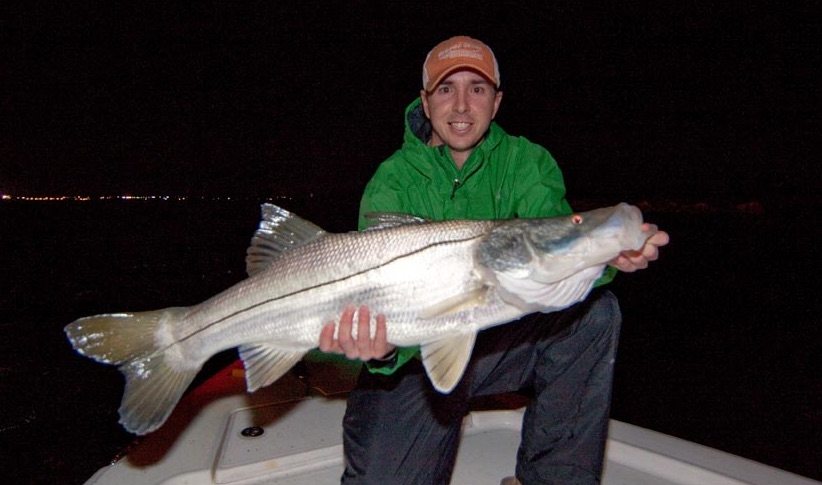When growing up in central Florida as a bass addict, I never thought I’d ever find a fish that was more enjoyable to pursue than a bass.
However, that quickly changed when I caught my first snook… which I concluded was essentially a bass on steroids that lives salt water.
Not only do the two species fight very similar (lots of jumps, headshakes, and aggressive runs), but they also have very similar feeding patterns.
But after years of pursuing both species while living in central Florida, I moved to the coast 12 years ago and have been completely addicted to inshore fishing for snook, redfish, and trout ever since.
And of the inshore species, snook are my primary focus due to the fact that they keep me connected to my bass fishing techniques learned while growing up and they just so happen to be excellent fighters and great table fare too.
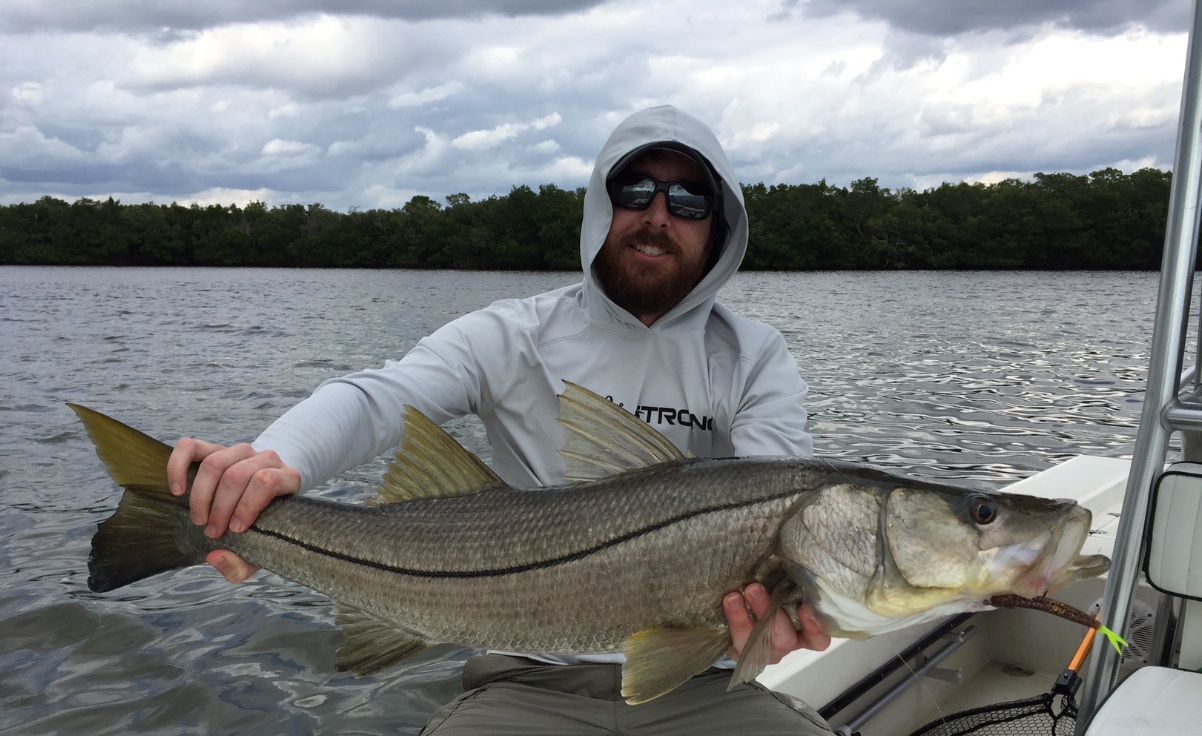
After receiving many questions about how to catch snook since launching Salt Strong, I thought an article like this that highlights important shortcuts to catching snook in Florida would be helpful for many saltwater anglers to increase the amount of snook caught per hour of fishing.
HERE ARE THE 5 HELPFUL TIPS FOR HOW TO CATCH SNOOK THAT WE’LL COVER IN THIS POST:
- Discover how to assess an area for feeding snook
- Live bait is not a requirement
- Use the right gear for the conditions
- Fancy boats are not a requirement
- Don’t be afraid of fishing in the dark…
Here are all five:
1. DISCOVER HOW TO ASSESS AN AREA FOR FEEDING SNOOK
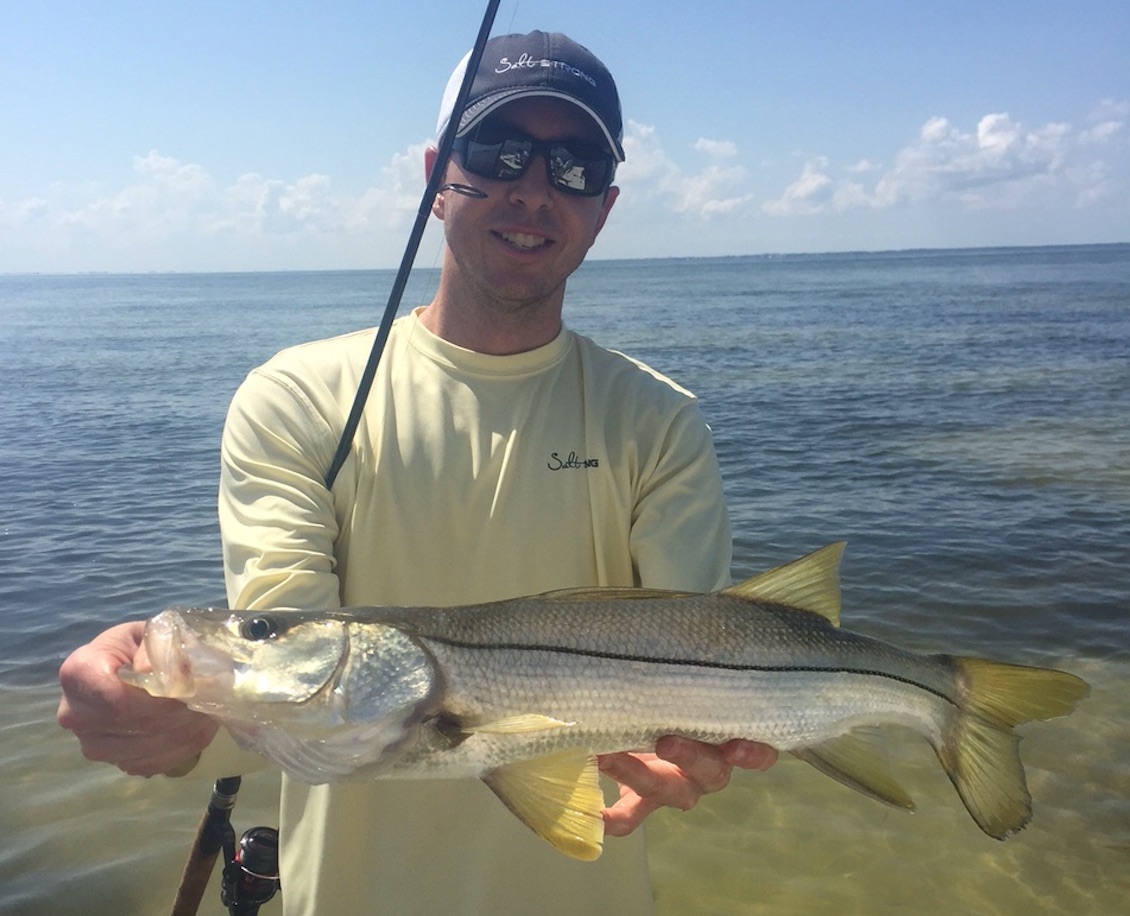
This is by far the most important shortcut of all, and it’s what causes most anglers to come home empty-handed… or nothing more than a measly catfish, which many believe are even worse than catching nothing at all.
To be able to consistently catch snook, it is absolutely essential to be able to quickly assess an area for it potential to be a feeding ground.
Without this knowledge, an angler will waste tons of time fishing in spots that have very little chance of success.
Fortunately, finding good snook feeding areas is not rocket science and doesn’t require a sixth sense…
In fact, you’ll be way ahead of the game if you simply focus on these 3 simple things:
- Current
- Structure
- Bait
Yes, these three simple and easy to distinguish variables will significantly help you find good areas to catch snook… even in regions that you’ve never even been to.
CURRENT
Snook are ambush predators that prefer to stay still and pounce on an unsuspecting prey, and current significantly helps them get more food with less effort… so they most often hang around areas that have current (kinda like how we humans get lazy at times knowing that we can simply go to a drive thru lane for food).
STRUCTURE
Just like most ambush-oriented species, snook prefer to hang around structure. And since they’re in the middle of the food chain, they like structure for two reasons…
- Feeding station – Just as snook seek protection from larger predators by hanging near structure, well many of the smaller fish that snook feed upon do the exact same thing.
- Protection from predators – Yes, even the big snook can fall prey to a bigger and faster predator… most notoriously dolphin which like them about as much as we do (click below to see a dolphin outwit a big snook along a shoreline).
BAIT
If one could read a snook’s mind, my guess is that it is focused on only two overall objectives…
- Where can I find food?
- How do I not get eaten by something else?
And since food is a top thought for these snook, you better believe that they most often hold close to a food source…
So when you don’t see any signs of baitfish in an area that you’re fishing (ripples/splashes on the water, small pecks at your lure/bait, etc.), it’s typically a good idea to move on to another spot.
And to consistently find snook, it’s best to seek out spots that have ALL 3 of the listed items… current, structure, AND bait.
2. LIVE BAIT IS NOT A REQUIREMENT
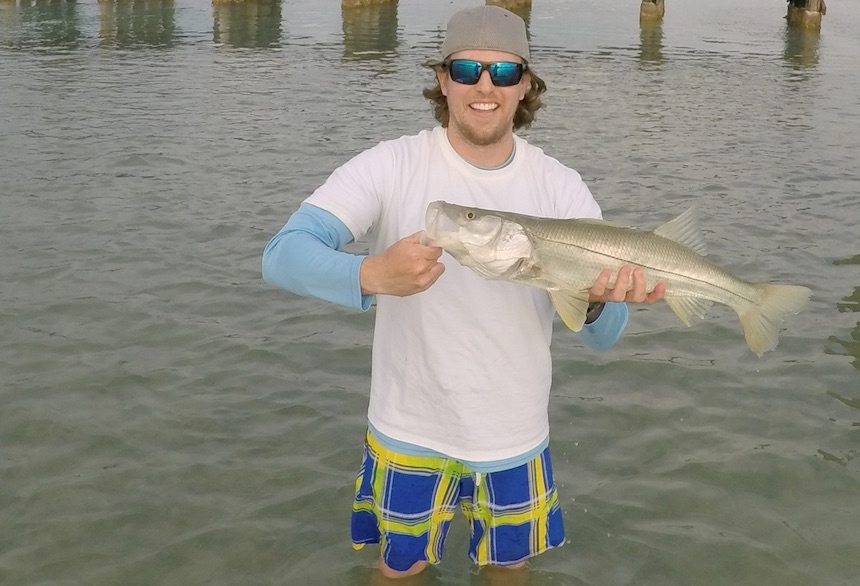
Although the TV shows most often feature guides using live bait for snook, it most certainly is not required.
I do most of my snook fishing with artificial lures throughout the year because it frees up a ton of time and energy in having to catch live bait.
In fact, we made a decision to ONLY fish with artificial lures when filming the Salt Strong music video called “Fishing In Our Soul” since our core online training course focuses on catching slams with artificial lures…
And the pressure was on because we only had 2 half days to film in an area none of us had been to in a couple months, and we really needed to get a ~20 lb snook…
And you’ll never guess where we caught the big snook shown at the 1:03 mark…
Yep, it was caught from a spot with structure, current, AND bait.
It was a flat with an oyster bar and many potholes near it (both forms of structure) that had plenty of current (max outgoing) with lots of bait on it (mullet, ballyhoo, pinfish, glass minnows, and whitebait).
All it takes is matching the right lure to the right spot… and since we already covered the spot (current + structure+ bait), now we just have to have a lure based on different combinations of those structures.
Which leads right into shortcut #2… gear recommendations.
3. USE THE RIGHT GEAR FOR THE CONDITIONS
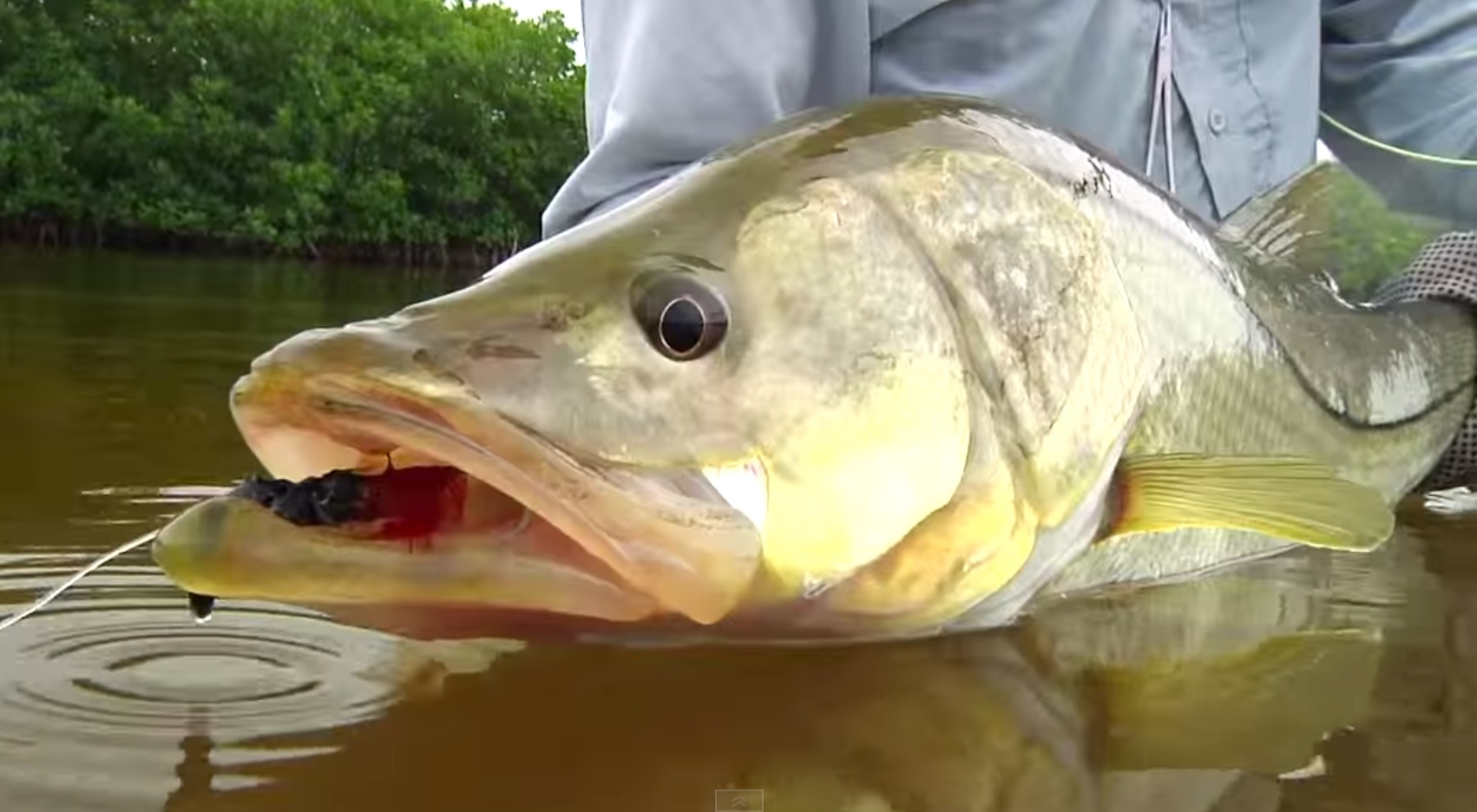
As stated earlier, catching snook can be done with using either artificial lures or live bait.
And it’s very important to match our gear to both the type of lure/bait we’re using as well as the area we’re fishing.
For example, it would not be practical to use a 30 lb leader on 10 lb main line to fish for snook in an inlet like Sebastian Inlet that has extremely strong current with lots of structure (too light to pull a big fish against the flow around rocks).
But it would also not be practical to use a 40 lb main line with 60+ lb leader while trying to catch a big snook on artificial lure up on a big grass flat with slow current because it would significantly hinder casting performance and it would make it tough to effectively work the bait to draw a strike.
So the lesson is… Match gear for the Conditions.
BEST FISHING LINE FOR SNOOK
Here’s a quick list of conditions I often fish with the respective line sizes that I typically use:
- Open grass flat with slow current: 10-15 lb braid with 30-40 lb leader
- Mangrove line or docks with slow/medium current: 15-20 lb braid with 40-50lb leader
- Fast-moving current with structure: 30-40 lb braid with 50-80 lb leader
Note: Click here to see exactly how to tie a leader system for snook.
BEST BAIT FOR SNOOK
A snook’s feeding pattern, of course, fluctuates throughout the year and even throughout the day in many cases…
The best way to determine what bait is best to use is simply using whatever is most prevalent in the area you’re fishing at the time.
For example, we hosted a wounded warrior from TX down in southwest FL in March and we found a spot with good current, structure, and ton of pinfish… so we knew that the snook were honed in on pinfish allowing for us to easily make a fun how-to video that included a snook catch.
However, selecting the ideal live bait for snook isn’t always that easy to determine so it’s often best to catch a few different types to see which one gets the most action.
Here’s a quick like of good baits for snook:
- Pilchards
- Shrimp
- Pinfish
- Pigfish
- Croakers (Atlantic)
- Grunts
- Mullet
- Ladyfish
- Ballyhoo
Any of these are great options, and it’s best to match hook size to the size of the bait being used… small bait like a shrimp will require a much smaller hook compared to a hog leg mullet.
Live Bait Tip: Hook your baits toward their nose if the current is ripping so they appear to be swimming naturally when getting pulled through the water, and hook baits towards the tail when fishing light current so you can direct the fish to swim away from you towards the structure by simply pulling on the line (see example below for a live mullet).
NOTE: MAKE SURE TO USE CIRCLE HOOKS WHEN LIVE BAIT FISHING FOR SNOOK BECAUSE THEY WILL HELP KEEP OUT-OF-SLOT FISH FROM GETTING INJURED.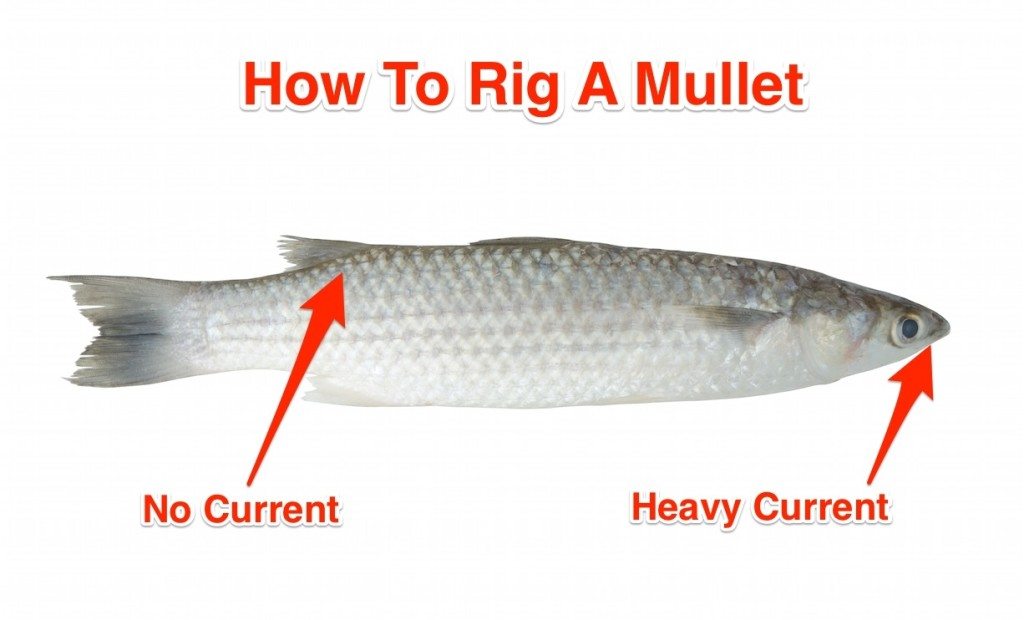 BEST LURES FOR SNOOK
BEST LURES FOR SNOOK
I like to simplify lure selection by categorizing options based on the holding depth the snook are holding (and I’ll just carry one or two per category to keep me focused on the most important aspects… feeding depth and presentation style).
Here are the best lures for snook by depth category:
- Shallow Depth (under 2 ft. of water) – Topwater plugs, soft plastic jerk baits, and hard plastic suspending twitch baits
- Mid Depth (2 ft. to 5 ft.) – Jigs, bucktails, swim baits, and small lipped crankbaits
- Deep (5 ft.+) – Heavier jigs/bucktails, swim baits, and large lipped crankbaits
Note: My absolute favorite way to catch snook is on a hand-made jig… click here to learn how to make your own bucktail jigs using items that you may already have.
BEST SNOOK ROD AND REEL
There are an enormous amount of options for rods these days… and it can certainly be mind-blowing for many anglers and certainly cannot be answered in a short post…
So I recommend going to a local tackle shop or two to have a local help you out if you’re confused.
But here are the two questions should be considered:
- Will you be fishing heavy or light current?
- Will you be using live bait or artificial lures?
If you feel that you’re answers are towards the first two options (heavy current and live bait), then getting a strong rod/reel with heavier line is probably the best bet.
But if you’ll more likely be fishing light current with artificial lures (my personal favorite), then it’s necessary to use lighter lines with sensitive rods that allow for better presentations and feel of the lure.
4. FANCY BOATS ARE NOT REQUIRED
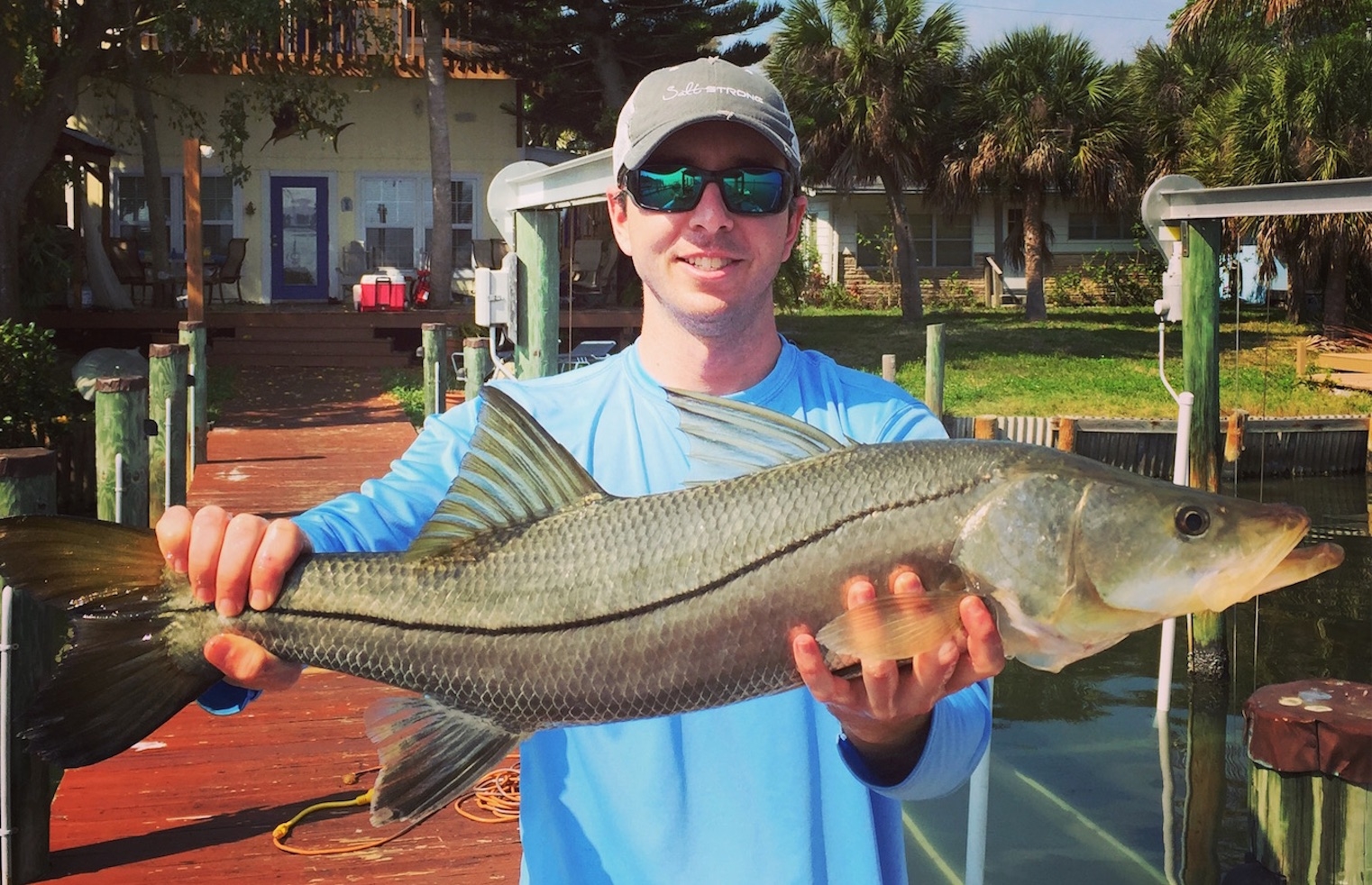
One of the most common excuses I hear on why people don’t fish very often is that they would go frequently if only they had a boat… or a nicer kayak… or anything other than simply walking along the shore or paddling to a nearby mangrove line.
For example, here’s a short video showing a slot sized snook caught from my beat up paddleboard during a lunch break:
BEACH FISHING FOR SNOOK
A simple walk along a beach on either coast in central to south FL can be a tremendous opportunity to catch snook from spring all the way until the end of fall (and some spots near inlets/passes can be productive in the winter).
Best of all, snook are most often cruising right along the edge of the shoreline so there is often many sight fishing opportunities to enjoy.
When beach fishing, be sure to keep in mind that snook will most often be facing into the current, so you’ll want to cast up the beach into the current so your presentation will be coming towards the snook because that’s the same direction that they’re expecting natural prey to be coming from.
And my recommendation for catching snook quickly is to use a small white jig with a red head because it works great and will save a ton of time and hassle compared to live bait fishing…
Click here to read a post about my favorite beach lure for snook.
Beach Fishing Tips: Beach fishing for snook is best right after the goes up and right before it goes back down. The biggest snook seem to get right up along the shoreline at high tide, and will venture a bit further out as the water drops. And make sure to take note of any underwater structure or even the slightest change in elevation of the shoreline because even the smallest of features can be a great feeding zone.
PADDLE FISHING FOR SNOOK
Given how easy it is to store, transport, and maintain a kayak or paddleboard compared to a flats boat, paddle fishing has exploded over the past 10+ years.
And it isn’t just their comparatively low costs… kayaks and paddleboards are actually extremely effective in catching many snook given how quiet they are along with the fact that they can go anywhere.
Best of all, they present an opportunity to effectively fish when time is very limited. In fact, I used to often go before and/or after work when in the corporate world… and now frequently go on long lunch breaks when the weather is too good to resist.
Here’s a quick video showing the added adventure that paddle fishing can bring to the table…
5. DON’T BE AFRAID TO FISH IN THE DARK
Although snook most certainly feed during the day, they are designed for feeding at night.
The fact that they have large eyes that sit way up on their heads with that very distinguished lateral line along its body that can sense movement in the water makes them tremendous predators at night.
And one of the most popular ways to target snook at night is by fishing around dock or bridge lights where snook congregate to pounce on the many baitfish and crustaceans that get attracted to the light.
For fishing lights at night, my absolute favorite live bait is a live ballyhoo… even the most pressured snook most often won’t turn that down.
Also, any of the live baits mentioned above can work great too.
For artificials, it can be a bit more difficult because at times because the popularity of this type of snook fishing means that they have likely seen every lure known to man multiple times.
So my tip here is to make sure to cast up current and try some retrieves that are way faster than what you normally do because this will often trigger a reaction-based bite.
Important Note: Make sure you’re very familiar with the area during the day before venturing out at night and be sure to check all lights and safety equipment before going out.
CONCLUSION
Snook fishing can be an incredibly fun and rewarding excursion if done properly.
And as you saw above, the ability to catch snook in Florida doesn’t require a fancy boat or any kind of sixth sense that only fishing guides possess…
All you need to focus on when in search for snook are the 3 simple core features:
- Current
- Structure
- Bait
And then be sure to match your gear to the area your fishing along with the type of bait/lure you plan to use and know that you can have a good chance of landing a nice snook even if you only have a short amount of free time by simply getting out on the beach either early in the morning or late in the evening with a light rod/reel and a trusted jig.
Note: If you’re interested in being able to consistently catch quality slams of redfish, snook, and trout, then be sure to check out our Insider Fishing Club because it is guaranteed to produce results for you…
Not only do we guarantee that you’ll be catching more inshore slams than ever before, but we guarantee that you’ll be able to save a lot of money on tackle by the group discounts the club gets now that it is over 12,000 members.
Related Posts:
1. The #1 Reason Anglers Aren’t Consistently Catching Snook
2. This Is What Can Happen When Fishing For Snook On A 3rd Floor Balcony
3. The Best Tides For Snook, Redfish, & Seatrout
4. How To Rig A Live Pinfish For Snook
Related Courses:
1. How To Catch More Snook In Less Time… Guaranteed!
2. How To Catch Inshore Slams (Snook, Redfish, & Seatrout) Without Needing Live Bait
P.S. – If you think your friends or fishing network would enjoy this post, please Tag them or Share this with them. It would mean a lot to me.


